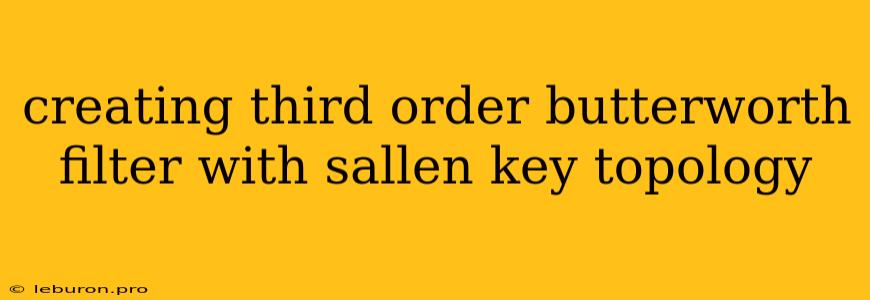Creating a third-order Butterworth filter using the Sallen-Key topology is a common technique in analog circuit design. Butterworth filters are known for their flat passband response and smooth roll-off characteristics, making them suitable for a wide range of applications, including audio filtering, signal conditioning, and data acquisition systems. The Sallen-Key topology, on the other hand, offers a simple and practical implementation using operational amplifiers (op-amps) and passive components. This article will delve into the design process of a third-order Butterworth filter using the Sallen-Key topology, explaining the underlying principles and providing a step-by-step guide for implementing such a filter.
Understanding Butterworth Filters and Sallen-Key Topology
Butterworth Filters: A Primer
Butterworth filters are a type of linear filter characterized by their maximally flat passband response. This means that the filter's gain is constant across the desired frequency range, ensuring minimal distortion of the signal within the passband. As the frequency increases beyond the cutoff frequency (f<sub>c</sub>), the filter's gain gradually rolls off, achieving a smooth transition from the passband to the stopband. The order of a Butterworth filter determines the steepness of this roll-off, with higher-order filters exhibiting a steeper slope.
Sallen-Key Topology: A Versatile Circuit
The Sallen-Key topology is a popular active filter configuration utilizing an op-amp, two resistors, and two capacitors to realize second-order filters. Its versatility lies in its ability to implement various filter types, including low-pass, high-pass, band-pass, and band-stop. The Sallen-Key topology offers advantages such as low component count, ease of implementation, and relatively predictable performance.
Designing a Third-Order Butterworth Filter using Sallen-Key Topology
Cascading Sallen-Key Stages
A third-order Butterworth filter can be realized by cascading two second-order Sallen-Key stages. Each stage is responsible for contributing a portion of the overall filter response. To ensure the desired Butterworth characteristics, specific values for the resistors and capacitors in each stage must be carefully chosen. The cascading process combines the responses of individual stages, resulting in the desired third-order Butterworth filter.
Deriving Filter Components
The process of deriving the filter component values involves using the Butterworth filter design equations and the Sallen-Key topology equations. These equations relate the desired cutoff frequency (f<sub>c</sub>) and filter order to the component values. For a third-order Butterworth filter, the general form of the transfer function is:
H(s) = 1 / (s^3 + 2s^2 + 2s + 1)
This transfer function can be factored into two second-order transfer functions, each corresponding to a Sallen-Key stage:
H(s) = H1(s) * H2(s)
where:
- H1(s) represents the transfer function of the first stage.
- H2(s) represents the transfer function of the second stage.
The specific values for the resistors and capacitors in each stage can be calculated using the following equations:
Stage 1:
- R1 = R2 = R
- C1 = C2 = C
- K = 1
Stage 2:
- R1 = R
- R2 = 2R
- C1 = C
- C2 = C/2
- K = 1/2
Here, 'K' represents the gain factor of the op-amp. In most cases, a gain of 1 is sufficient. The calculated values of resistors and capacitors will ensure the desired Butterworth characteristics for the filter.
Implementation Considerations
When implementing the filter, certain considerations are crucial:
- Op-amp Selection: Choosing an op-amp with appropriate bandwidth, slew rate, and input impedance is vital. For low-frequency applications, a general-purpose op-amp like the LM741 might suffice. For higher frequencies, a faster op-amp with a higher bandwidth is required.
- Component Tolerance: The component tolerances of resistors and capacitors affect the filter's frequency response. Using components with tight tolerances can help ensure accuracy and minimize deviations from the intended design.
- Signal Level: The input signal level should be within the op-amp's operating range to prevent distortion. It might be necessary to use an input amplifier stage if the signal level is too low or to add an output buffer stage if the output load is high.
Example: Design of a Third-Order Butterworth Low-Pass Filter at 1kHz
To illustrate the design process, consider designing a third-order Butterworth low-pass filter with a cutoff frequency of 1 kHz.
- Select the Sallen-Key configuration: For a low-pass filter, the Sallen-Key configuration with two capacitors in the feedback loop is used.
- Choose the cutoff frequency: f<sub>c</sub> = 1 kHz.
- Calculate component values: Using the equations above, and assuming R = 10 kΩ, we get the following values for the resistors and capacitors:
Stage 1:
- R1 = R2 = 10 kΩ
- C1 = C2 = 15.9 nF
Stage 2:
- R1 = 10 kΩ
- R2 = 20 kΩ
- C1 = 15.9 nF
- C2 = 7.95 nF
- Build the circuit: Connect two Sallen-Key stages using the calculated component values.
- Test and analyze: Measure the frequency response of the filter using a spectrum analyzer or function generator. The measured response should closely match the theoretical response of a third-order Butterworth filter.
Conclusion
Designing a third-order Butterworth filter using the Sallen-Key topology is a straightforward process with readily available components and design tools. This type of filter offers a smooth passband response and predictable roll-off characteristics, making it suitable for various applications. By understanding the principles of Butterworth filters and Sallen-Key topology, along with the proper selection of components and implementation considerations, you can successfully design and implement a third-order Butterworth filter for your specific requirements.
